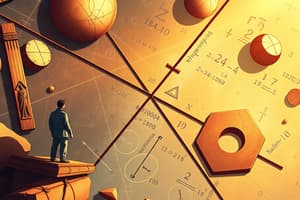Podcast
Questions and Answers
The multiplication of a number by 5 will always end in either 0 or 2.
The multiplication of a number by 5 will always end in either 0 or 2.
False (B)
Skip counting is a technique used to help learn the multiplication tables efficiently.
Skip counting is a technique used to help learn the multiplication tables efficiently.
True (A)
The product of any number multiplied by 1 is always different from the original number.
The product of any number multiplied by 1 is always different from the original number.
False (B)
Using flashcards is not an effective method for memorizing multiplication facts.
Using flashcards is not an effective method for memorizing multiplication facts.
Multiplication is defined only as repeated addition of two factors.
Multiplication is defined only as repeated addition of two factors.
Understanding the components of multiplication, such as factors and products, is important for learning multiplication.
Understanding the components of multiplication, such as factors and products, is important for learning multiplication.
Memorization techniques like songs and rhymes are ineffective for learning multiplication facts.
Memorization techniques like songs and rhymes are ineffective for learning multiplication facts.
The multiplication table typically includes numbers from 1 to 20.
The multiplication table typically includes numbers from 1 to 20.
Flashcards are hidden until you start studying
Study Notes
Learning Multiplication
-
Definition: Multiplication is one of the four basic operations of arithmetic, representing the repeated addition of a number.
-
Multiplication Table: A tool used to visualize and memorize the products of pairs of numbers.
- Typically includes numbers 1 through 12 or 1 through 10.
- Displayed in a grid format where one axis represents one factor and the other axis represents the second factor.
-
Strategies for Learning:
- Repetition: Regular practice helps commit the multiplication facts to memory.
- Patterns:
- Multiplying by 1: Any number remains the same.
- Multiplying by 2: Results in doubling the number.
- Multiplying by 5: Ends in either 0 or 5.
- Multiplying by 10: Adds a zero to the end of the number.
- Skip Counting: Counting by a specific number, e.g., counting by 3s to learn the 3 times table.
- Visual Aids: Use of charts, grids, and interactive apps for engaging learning.
-
Understanding Components:
- Factors: Numbers that are multiplied together.
- Product: Result of the multiplication of two factors.
-
Memorization Techniques:
- Songs and Rhymes: Rhythmic patterns can aid memory retention.
- Flashcards: Quick review of multiplication facts.
- Games: Incorporate competitive and fun elements to reinforce learning.
-
Application:
- Used in various real-life scenarios such as calculating area, budgeting, and problem-solving.
- Foundation for more advanced mathematical concepts like division, fractions, and algebra.
-
Common Multiplication Facts:
- 1 x n = n
- 2 x n = n + n
- 3 x n = n added to itself three times
- 4 x n = n added to itself four times
-
Practice: Regularly practice multiplication by solving problems, using worksheets or online resources, and progressively increasing difficulty as mastery improves.
Definition of Multiplication
- Multiplication is a fundamental arithmetic operation, defined as repeated addition of a number.
Multiplication Table
- A visual tool to assist in memorizing products of number pairs, typically covering numbers 1 to 10 or 1 to 12.
- Arranged in a grid format, where each axis represents a different multiplicand.
Strategies for Learning
-
Repetition: Engaging in consistent practice solidifies multiplication facts into memory.
-
Patterns: Recognizing patterns simplifies learning:
- Multiplying by 1 keeps the number unchanged.
- Multiplying by 2 results in doubling.
- Multiplying by 5 yields products ending in 0 or 5.
- Multiplying by 10 appends a zero to the end of the number.
-
Skip Counting: Counting by a chosen number (e.g., by 3s) aids in mastering respective multiplication tables.
-
Visual Aids: Utilization of charts, grids, and interactive applications fosters engaging and effective learning experiences.
Understanding Key Components
- Factors: Numbers that are multiplied together.
- Product: The outcome of the multiplication process between two factors.
Memorization Techniques
- Songs and Rhymes: Using rhythmic patterns enhances retention of multiplication facts.
- Flashcards: Employing flashcards allows for quick and efficient review of multiplication facts.
- Games: Engaging in competitive games encourages learning through fun interactions.
Application of Multiplication
- Multiplication is essential in practical situations, including area calculation, budgeting, and various problem-solving scenarios.
- It underpins more complex mathematical topics such as division, fractions, and algebra.
Common Multiplication Facts
- 1 x n = n (Identity property)
- 2 x n = n + n (Doubling)
- 3 x n = n added to itself three times
- 4 x n = n added to itself four times
Practice Recommendations
- Regular problem-solving practice is crucial. Use worksheets or digital resources and progressively tackle more challenging problems as confidence and mastery grow.
Studying That Suits You
Use AI to generate personalized quizzes and flashcards to suit your learning preferences.




